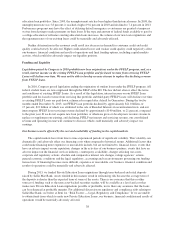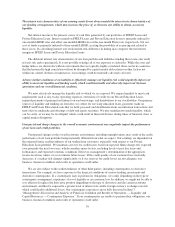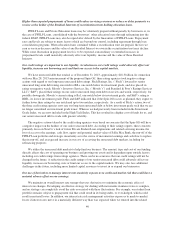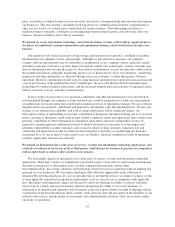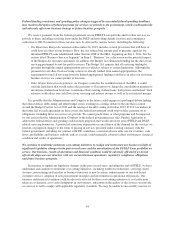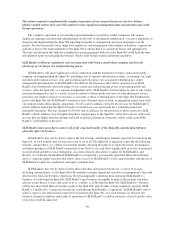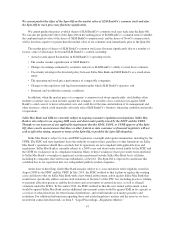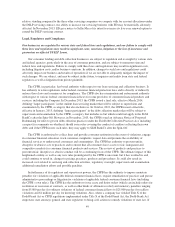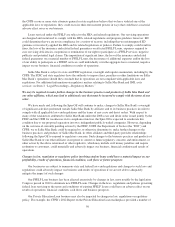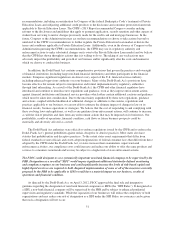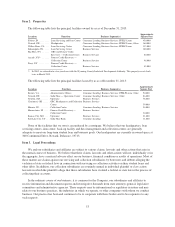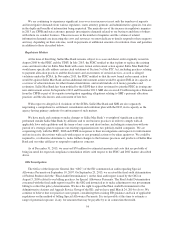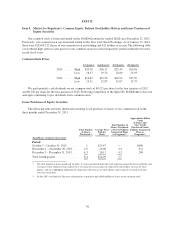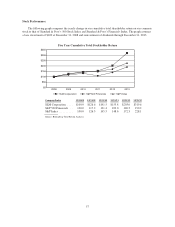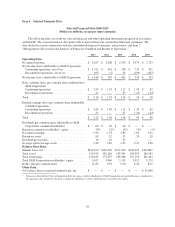Sallie Mae 2013 Annual Report Download - page 50
Download and view the complete annual report
Please find page 50 of the 2013 Sallie Mae annual report below. You can navigate through the pages in the report by either clicking on the pages listed below, or by using the keyword search tool below to find specific information within the annual report.SLM BankCo and NewCo will each be subject to restrictions under a tax sharing agreement between them,
and a violation of the tax sharing agreement may result in tax liability to SLM BankCo and to its stockholders
at the time of the Spin-Off.
In connection with the Spin-Off, SLM BankCo will enter into a tax sharing agreement with NewCo to
preserve the tax-free treatment of the separation and distribution of NewCo. Under this tax sharing agreement,
both SLM BankCo and NewCo will be restricted from engaging in certain transactions that could prevent the
Spin-Off from being tax-free to SLM BankCo and its stockholders at the time of the Spin-Off for U.S. federal
income tax purposes. Compliance with the tax sharing agreement and the restrictions therein may limit SLM
BankCo’s near-term ability to pursue certain strategic transactions or engage in activities that might be beneficial
from a business perspective, including M&A transactions. This may result in missed opportunities or the pursuit
of business strategies that may not be as beneficial for SLM BankCo and which may negatively affect SLM
BankCo’s anticipated profitability. Were NewCo to fail to comply with the restrictions in the tax sharing
agreement and as a result the Spin-Off was determined to be taxable for U.S. federal income tax purposes, SLM
BankCo and its stockholders at the time of the Spin-Off that are subject to U.S. federal income tax could incur
significant U.S. federal income tax liabilities. Although the tax sharing agreement will provide that NewCo is
required to indemnify SLM BankCo for taxes incurred by SLM BankCo that may arise were NewCo to fail to
comply with its obligations under the tax sharing agreement, there is no assurance that NewCo will have the
funds to satisfy that liability. Also, NewCo will not be required to indemnify our stockholders for any tax
liabilities they may incur for its violation of the tax sharing agreement.
Competition
We operate in a competitive environment. Our product offerings are primarily concentrated in loan and
savings products for higher education.
We compete in the private credit lending business with banks and other consumer lending institutions, many
with strong consumer brand name recognition and greater financial resources. We compete based on our
products, origination capability and customer service. To the extent our competitors compete aggressively or
more effectively, we could lose market share to them or subject our existing loans to refinancing risk. Our
product offerings may not prove to be profitable and may result in higher than expected losses.
We are a leading provider of saving- and paying-for-college products and programs. This concentration
gives us a competitive advantage in the marketplace. This concentration also creates risks in our business,
particularly in light of our concentrations as a Private Education Loan lender and as a servicer for the FFELP and
DSLP. If population demographics result in a decrease in college-age individuals, if demand for higher education
decreases, if the cost of attendance of higher education decreases, if public resistance to higher education costs
increases, or if the demand for higher education loans decreases, our consumer lending business could be
negatively affected. In addition, the federal government, through the DSLP, poses significant competition to our
private credit loan products. If loan limits under the DSLP increase, DSLP loans could be more widely available
to students and their families and DSLP loans could increase, resulting in further decreases in the size of the
Private Education Loan market and demand for our Private Education Loan products.
We serviced approximately 5.7 million accounts under a DSLP servicing contract with ED as of
December 31, 2013. We compete for DSLP servicing volume from ED with three other servicing companies with
whom we share the contract. New account allocations for each contract year are awarded annually based on each
company’s performance on five different metrics over the most recently ended contract year: defaulted borrower
count; defaulted borrower dollar amount; a survey of borrowers; a survey of schools; and a survey of ED
personnel. Pursuant to the contract terms related to annual volume allocation of new loans, the maximum a
servicer can be awarded for any new contract year is 40 percent of net new borrowers in that contract year. We
ranked last in the allocation of net accounts for the upcoming contract year. Our allocation of new customer loans
serviced for ED under the DSLP servicing contract was 15 percent for the most recent contract year and is 18
percent for the upcoming contract year. If we are unable to improve on our performance metrics and increase our
48


